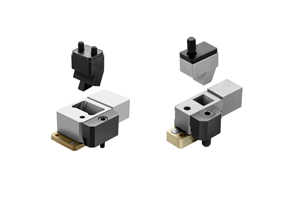Transitioning from CAD to CAM Pays Off
Like the majority of moldmakers, this shop generates revenue not by selling a 3D file of a mold as an engineering service, but by delivering the final physical mold. Investing in CAM software has helped the team to design short-run tools, which keeps loyal customers constantly coming back to them.
Traditional craftsmen’s skills are paramount when designing and machining molds and tools, and Colin Merry, owner of DJM Engineering in Banbuy, UK has learned his skills from scratch in his company, which was founded by his father David in 1990.
“I learned everything from highly-skilled toolmakers. I’d often see two or three ways of doing something, and I’d pick the one that seemed to be the most effective,” Merry says. Today, the company combines moldmaking with general engineering services, manufacturing components for the medical, aerospace and automotive industries.
DJM Engineering produces around four or five special molds in an average year, each one taking between one and four weeks, for customers requiring small production runs of just a few thousand, and, in some cases, even one-offs. “It’s a different style of tooling, with a lot of wire erosion sections,” Merry explains. “The days have gone when we used to spend two or three months building large, complex, tools with multiple cavities in hardened steel to run millions of plastic injection parts.”
“Many customers may only have an idea of the end product, or just a paper drawing. So we draw something up for them and add the shrinkages in our new CAM software Edgecam, building the tool around it. We have standard catalogues so it’s easy to download the tool base, and I always try to start machining the cavities and cores as soon as possible.”
We’re all about simply trying to help people.
As a skilled toolmaker with many years’ experience, Merry is able to accurately create and place all ejector pins and gates with Edgecam. Even complex molds present no problem to design in Edgecam, he says. He cites an example of an agricultural earth-moving part requiring pins on a number of flat surfaces, an ejector stem covering the internal face opposite the nozzles on the moving half. “Being able to do all this with Edgecam, instead of specialist mold and die CAD/CAM software all comes through my training and experience, having built more than 600 molds during my career.” And he says the filling is taken care of by pulling the CAD in from the nozzle supplier and inserting it straight into his part file.
Once the designs are complete, the molds are machined on one of the company’s three CNC machines. “If the part is to be machined on either our Hurco VM 10 or XYZ 500 LR mills, we initially create roughing and profiling cycles, and while they are running we’ll work on the remaining programs.” The XYZ 500 LR mill was the first of its kind in the UK when they installed it, and is the first XYZ machining center to feature linear rail guide technology. “We’re using it with the latest WNT cutting tools, and as we’re programming it with Edgecam we’re definitely not holding back on speeds and feeds across a range of materials.”
And if it’s a turning part, it goes through a DXF converter and is being machined on their XYZ 1630 lathe in a matter of minutes, Merry explains.
Edgecam drives both, milling and turning operations, and the company uses it on all components. “Because our molds are high precision, we need to ensure that we get everything right first time, every time. Without Edgecam we’d struggle to be what are and do what we do.”
Concluding, he says: “We may be a bit old fashioned in our approach in that we’re all about simply trying to help people, but it does mean that customers keep coming back to us.”
Related Content
To the Next Level: Hot Runners, Mold Components Solutions and Services
Moldmaking can be a complex business, but things can be simplified with the right hot runner and mold component technologies and services.
Read MoreEnhance Your Moldmaking Capabilities With These Hot Runner and Mold Component Products
MMT highlights new and improved innovations, including data collection devices, pins, bases, controllers, bushings, nozzles, positioning systems and much more.
Read MoreHow to Supply Cooling to Additive Tooling
Additive tooling provides limitless options for cooling a mold’s difficult-to-cool areas.
Read MoreFundamentals of Designing the Optimal Cooling System
The right mold components can help improve mold cooling and thereby produce higher-quality parts.
Read MoreRead Next
How to Use Strategic Planning Tools, Data to Manage the Human Side of Business
Q&A with Marion Wells, MMT EAB member and founder of Human Asset Management.
Read MoreReasons to Use Fiber Lasers for Mold Cleaning
Fiber lasers offer a simplicity, speed, control and portability, minimizing mold cleaning risks.
Read MoreHow to Use Continuing Education to Remain Competitive in Moldmaking
Continued training helps moldmakers make tooling decisions and properly use the latest cutting tool to efficiently machine high-quality molds.
Read More.jpg;maxWidth=970;quality=90)








.jpg;maxWidth=300;quality=90)

_300x250 3.png;maxWidth=300;quality=90)















_970x250 1.png;maxWidth=970;quality=90)